By June Shrestha, MLML Ichthyology Lab
I'm happy to share that we've had a total of 13 students students defend their theses in 2019! Please join me in congratulating the students, and read below to learn a little more about their research.
- Steven Cunningham, Phycology
- Amanda Heidt, Invertebrate Zoology
- Sharon Hsu, Vertebrate Ecology
- Brijonnay Madrigal, Vertebrate Ecology
- Cynthia Michaud, Physical Oceanography
- Elizabeth Ramsay, Phycology
- Katie Harrington, Vertebrate Ecology
- Jessica Jang, Pacific Shark Research Center
- Melissa Nehmens, Pacific Shark Research Center
- Stephen Pang, Ichthyology Lab
- Patrick Daniel, Physical Oceanography
- Heather Barrett, Vertebrate Ecology
- Sierra Helmann, Biological Oceanography
Steven Cunningham
Phycology
Physical and Biological Consequences of Giant Kelp (Macrocystis pyrifera) Removals Within a Central California Kelp Forest
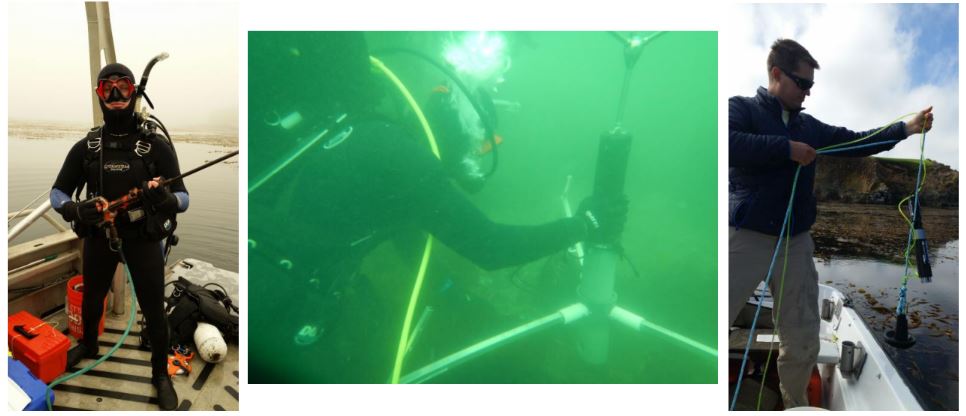
- Steven constructed the first-ever, full scale artificial giant kelp plots to investigate structural vs biogenic changes to particulate organic carbon concentrations.
- He found that small scale giant kelp removals don't change total particulate carbon but do alter particle distribution through the water column. Removing the structure of kelp allows more particulates to settle to the benthos while particulates appear to be well mixed through smaller kelp beds.
- Steven also discovered that waves interact with giant kelp by creating turbulence. This turbulence is able to move particles upwards through the water column, which is why when removed, particles are able to settle more readily.
Amanda Heidt
Invertebrate Zoology
Spatial characterization of meiofaunal diversity along the California coast and potential abiotic drivers"

- Amanda collected samples of sand at ten beaches along the California coast to study the communities of small organisms – known as meiofauna – that live between the grains. There can be tens of thousands of meiofauna in the space of a sandy footprint, and they include many different groups of animals, including water bears (tardigrades).
- She found that meiofauna respond to many facets of their environment. Temperature and salinity can structure groups of meiofauna over large distances, with more meiofauna found nearer to the equator. This trend of increasing diversity near the tropics is called the Latitudinal Diversity Gradient, and many plants and animals show similar trends.
- The sand itself also determines which meiofauna are likely to live on a given beach. Amanda used grain size analysis and mineralogy to show that communities change based on the local beach environment.
- While traditional studies pull individual meiofauna from the sand and identify them under a microscope, this study used DNA-based tools that are challenging many of the past difficulties in working with this group. Meiofauna are increasingly being used to assess ecosystem health, and this study will provide a baseline for future comparison.
Sharon Hsu
Vertebrate Ecology
Using stable isotopes to determine foraging regions of leatherback turtles: limitations of the isotope tracking technique in the western Atlantic Ocean
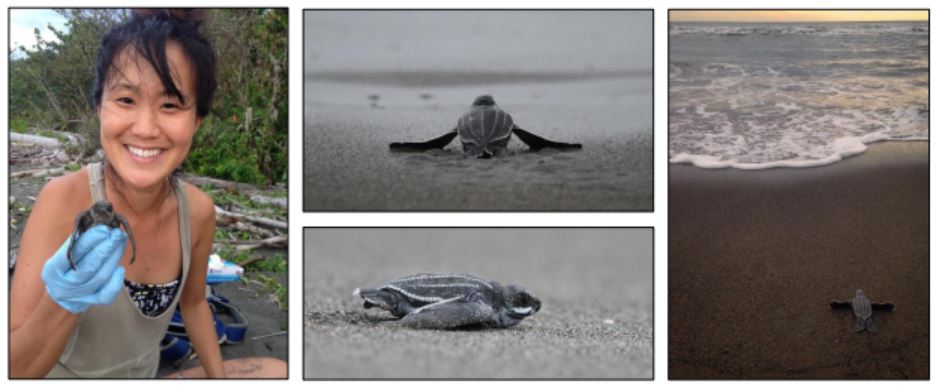
- In the Western Caribbean (Costa Rica), very little is known about leatherback (Dermochelys coriacea) foraging behavior. Where do they forage? How does a foraging area impact female body size and reproductive output?
- While most foraging studies use satellite telemetry to track the movements of migratory species, Sharon set out to see if stable isotope analysis alone, a more cost-effective technology, could determine the foraging areas of these endangered highly migratory species.
- She found that high variance in stable isotope values precluded using stable isotope analysis as a primary technique for determining foraging areas in the North Atlantic, and there was no relationship between foraging area and female body size/ reproductive output.
- While disappointing, Sharon concludes that stable isotope analysis still holds important complementary value to satellite telemetry for tracking highly migratory species. She also stresses the need for more published stable isotope data in the Gulf of Mexico and western North Atlantic regions.
Brijonnay Madrigal
Vertebrate Ecology
Determining ecotype presence and the call repertoire of killer whales (Orcinus orca) from passive acoustic monitoring near Point Hope, Alaska in the Southeastern Chukchi Sea
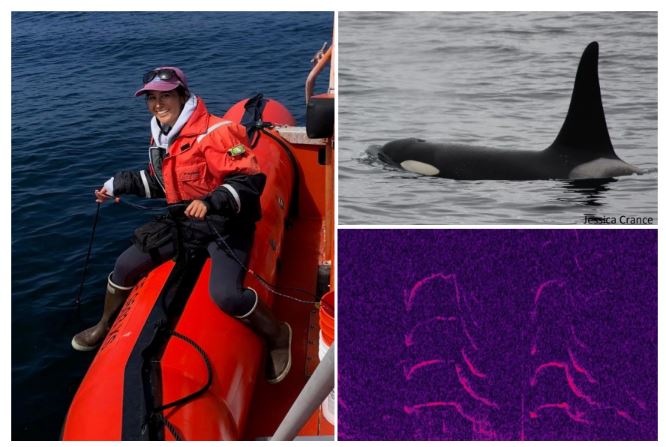
- Brijonnay used passive acoustic monitoring to discern the ecotype and call repertoire of killer whales (Orcinus orca) recorded at a site off Point Hope, Alaska in the Southeastern Chukchi Sea. This project was conducted in collaboration with the NOAA Alaska Fisheries Science Center Marine Mammal Lab who collected these data.
- A total of 1315 killer whale calls were detected on 38 days during the summers of 2013 to 2015. Calls were manually grouped into six categories based on the general call contours: multi-part, downsweep, upsweep, modulated, single modulation and tonal. The majority of detections were tonal calls (n = 607, 46%), and multi-part calls (n = 351, 27%) that contained high frequency and low frequency components.
- Brijonnay found that the transient ecotype was present at this site in the Chukchi Sea based on the call peak frequency and this ecotype determination was supported by previous literature.
- This study provides the first comprehensive, catalogue of transient killer whale vocalizations in this region and these data can serve as a baseline for future acoustic work on killer whales in the Arctic.
Cynthia Michaud
Physical Oceanography
Effects of phytoplankton composition and biominerals on composition on the episodic pulses of particulate organic carbon to abyssal depths

- There is a distinct difference in phytoplankton composition between high-flux events and low-flux events
- Large diatoms like Rhizosolenia are contributing more to the high-flux events, while smaller diatoms and coccolithophores are contributing less to the high-flux events
- Biogenic silica is contributing more to the ballasting of cells with increased POC flux compared to the particulate inorganic carbon
- The study suggests that during high-flux events particles are more heavily enriched in large highly silicified diatoms cells
Elizabeth Ramsay
Phycology
Morphological variability within Dictyonerum californicum and Dictyoneurum reticulatum along a wave exposure gradient on the Monterey Peninsula
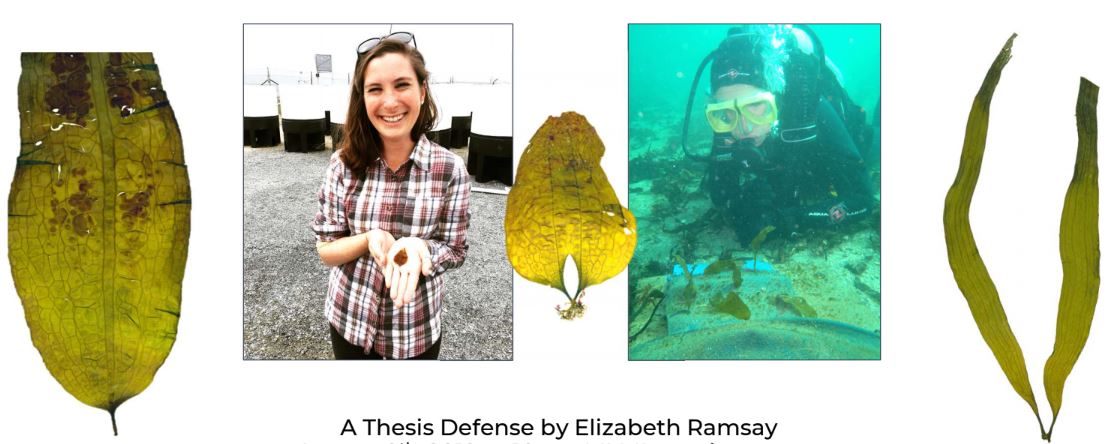
- Along the Monterey Peninsula lies two common understory kelp species, long thought to be two distinct species due to morphological differences. However, recent work suggests that the species are actually genetically indistinct. Elizabeth questioned: Could wave exposure drive the morphological variations?
- First, Elizabeth tested the effect of wave action on the presence or absence of a midrib, a hardened tissue structure in the middle of the kelp blade. She found that the understory kelps had a midrib when in sheltered sites, or at deeper depths when in the exposed sites.
- Second, Elizabeth examined the tendency for both species to split from the stipe through the lamina, creating two blades from the original one. She found that individuals that grew in clumps, instead of solitary individuals, more often lacked a midrib and split completely through the lamina.
- Interestingly, Elizabeth's results were most significant at sites of intermediate wave action. Sites extremely sheltered or exposed did not show much diversity in morphological traits.
- Based on her results, Elizabeth suggests that the morphological characteristic of the midrib, used to distinguish between these two kelp species, is plastic and not genetically fixed, and should therefore no longer be used to identify these two species.
Katie Harrington
Vertebrate Ecology
Seasonal time-energy allocation of an island-restricted Falconid, the Striated Caracara, using a low-cost, open-source inertial movement GPS logger

Jessica Jang
Pacific Shark Research Center
Reproductive Strategies of the Big Skate (Beringraja binoculata, Girard 1855) with evidence of multiple paternity.
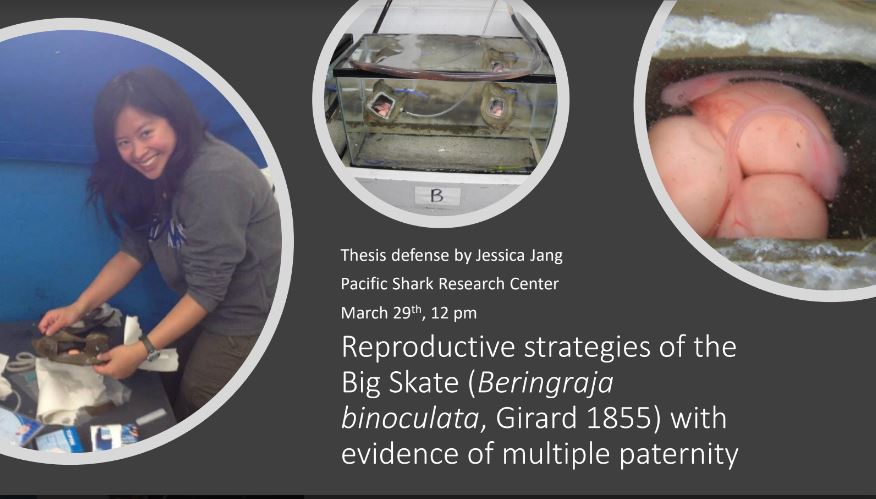
- Jessica collected Big Skate egg cases from California to Washington and looked at whether Big Skate egg cases size dimension and embryo numbers differed in captive and wild populations.
- Captive population had smaller egg cases and less embryos per egg case compared to the wild. Embryos in captivity were much smaller than from the wild. Big Skate egg cases sizes and embryo numbers peaked at 42 degrees north, suggesting that area is the most prolific due to upwelling conditions.
- Big Skates are one of two species of the 300+ known skates that exhibit multiple embryos within in an egg case. Using genetics, Jessica found that several males may sire within an egg case and female Big Skates can store sperm with a minimum of 3 months.
Melissa Nehmens
Pacific Shark Research Center
Life History of the Southern Lanternshark, Etmopterus granulosus, from the Southwestern Indian Ocean

- Melissa used microsatellite markers to look at reproductive and population genetics of the Southern Lanternshark, Etmopterus granulosus. Interestingly, she found that the Southern Lanternshark does not fit preconceived paradigms about elasmobranchs and reaffirms that life history studies need to be conducted to avoid inaccurate assumptions.
- She found that monogamy is the predominant mating system with a frequency of polyandry at 33%, suggesting the mating system is likely dynamic, and based on what is most beneficial at a given time
- As a species that is frequently caught as bycatch, it would be expected that the population would be in a numerical decline and be reducing in genetic diversity. Though little data is available to numerically assess Southern Lanternshark, the genetics do not show a reduction in genetic diversity.
- She also examined telomere length in different age classes to determine if telomeres shorten with relation to individual size. This method was used to see if this could potentially push traditional ageing studies away from chronological age to a biological age.
Stephen Pang
Ichthyology
The effect of sex ratio on the reproductive biology of two sex changing fish (Lythrypnus dalli and Rhinogobiops nicholsii)

- Stephen examined how size-selective fishing (i.e., targeting the largest individuals in a population) impacts the reproductive output of protogynous hermaphrodites. These species change sex from female-to-male so this size-selective tendency is also sex-selective since it preferentially removes males from the population. This is predicted to lead to male limitation.
- He used bluebanded and blackeye gobies as model species in the hopes that he'd be able to scale my results up to more recreationally- and commerically-important fishes
- He found that male limitation is not present in either species. Despite previous modeling work predicting sperm limitation, that work has mostly revolved around aggregate spawning species. Stephen thinks that he may not have seen sperm depletion/limitation in bluebanded or blackeye gobies due to their pair spawning mating strategy
- Stephen concluded that populations of protogynous hermaphrodites need to be managed holistically and need to take into account things like intrasexual competition, mate choice, and other components of their mating system
Patrick Daniel
Physical Oceanography
Contributions of wind- and wave-induced transport to nearshore phytoplankton variability in Northern California

- Off of the Bodega Headland in Northern California, the abundance of nearshore phytoplankton can increase rapidly at rates faster than would be explained by growth and are correlated with increases in offshore wave height. Patrick analyzed a a 5-year time series of intertidal chlorophyll data in order to explain the physical drivers responsible for the high frequency variability.
- He found that upwelling alone doesn’t explain the events, as the increases in offshore equatorial winds occurred simultaneously with increases in nearshore phytoplankton. Instead, phytoplankton abundance was correlated with increases in Stokes drift, a wave-induced surface transport.
- The timing of events suggests that Stokes drift is reinforced by alongshore winds, which impart energy to the wave spectrum, resulting in strong onshore transport of phytoplankton to the nearshore during periods of high wave energy.
Heather Barrett
Vertebrate Ecology
The energetic cost of human disturbance on the southern sea otter (Enhydra lutris nereis)"

- Heather collaborated with Sea Otter Savvy to investigate the energetic cost of human disturbance to the southern sea otter (Enhydra lutris nereis). Human disturbance to wildlife is a growing concern in conservation policy and management. As outdoor recreation increases there is a consequent rise in human-wildlife encounters. Thus, linking behavioral response to the energetic cost of the response could further our understanding of the true cost of the disturbance, and provide sound scientific basis for management. This is particularly a concern for sea otters due to their high metabolic costs, sensitive energetic budget, and threatened status.
- The project objectives were to use a newly developed Hidden Markov Model used to predict sea otter activity to determine the:
- 1) Frequency and severity of human disturbance to sea otters in California;
- 2) Factors that influence sea otter response and vulnerability to disturbance (i.e. pup presence, kelp canopy, group size, and time of day);
- 3) Daily energetic cost due to human disturbance using specific disturbance scenarios.
- Heather found that the degree of activity change due to human disturbance is specific to location and stimulus distance. The closer to a sea otter, the potential for disturbance increased exponentially. She also determined that kelp canopy and group size increase the likelihood of sea otters resting, thus increasing their vulnerability to increased activity due to a disturbance (i.e. resting otters are at higher risk to increase activity). Daily energetic costs were estimated (using previously recorded metabolic rates) and also supported that the energetic cost increases when stimuli are closer.
- In conclusion, disturbance to sea otters has an energetic cost, and the model is a useful tool that can provide quantifiable viewing distances or disturbance thresholds to inform management and policy decisions.
Sierra Helmann
Biological Oceanography
Resolution of the Chlorophyllide a Problem in the Routine Measurement of Chlorophyll a
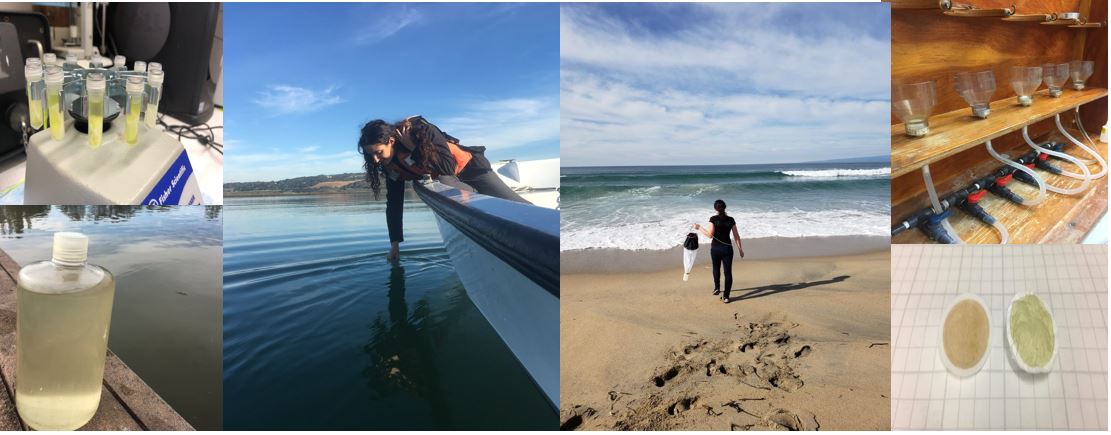
Congratulations to everyone!

